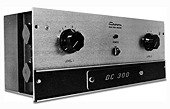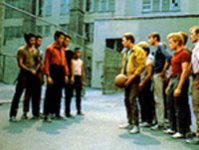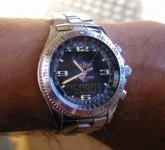I've got a pair of bridged Crown/Amcron's DC-300 Series II.
The sound fine to me (slightly modified), and nothing can kill them

The sound fine to me (slightly modified), and nothing can kill them

Sharks and Jets
I’ve spent lots of time listening to Bryston 4B as well as DC 300's. Both are venerable and solidly built amplifiers.
It would seem however that not everyone finds them "musical".
I think that either would make a good reference leading into the world of the esoteric high-end equipment. I can’t compare either to a $10K amplifier. I haven’t had the opportunity to spend much time at all listening to such things.
I didn’t need to nock the Crown product; I rather meant to point out that people get rather opinioned about such things as if Crown and Bryston are both good but antipodes. You are either a “Shark” or a “Jet”. Jets don’t find Brystons musical…
I’ve spent lots of time listening to Bryston 4B as well as DC 300's. Both are venerable and solidly built amplifiers.
It would seem however that not everyone finds them "musical".
I think that either would make a good reference leading into the world of the esoteric high-end equipment. I can’t compare either to a $10K amplifier. I haven’t had the opportunity to spend much time at all listening to such things.
I didn’t need to nock the Crown product; I rather meant to point out that people get rather opinioned about such things as if Crown and Bryston are both good but antipodes. You are either a “Shark” or a “Jet”. Jets don’t find Brystons musical…
Attachments
if the output impedance of an amp is very low the amp is less sensitive to occilation too
I wouldn't bet on that. One possibility of achieving low output impedance is a high NFB factor, which by itself can lead to insufficient phase-marging. Which by itself ........
Regards
Charles
phase_accurate said:
I wouldn't bet on that. One possibility of achieving low output impedance is a high NFB factor, which by itself can lead to insufficient phase-marging. Which by itself ........
Regards
Charles
u are right , thats one possibility , i was talking about using many output transistors🙂
sss said:but when we are making transistor amps , isnt our goal is to get as low as possible output impedance?
That's one of the audio gears problem. The best sounding systems I have ever had are systems that were tweaked with all the components being in the audio chain. When an amp is designed, it didn't put the accompanying components (pre, source, speaker) 100% into consideration. It is perfect being an individual amp (And so are speakers and others) but not necessarily is being in an audio system.
Why do you think an amp should have as low as possible output impedance??? If you look at the audio chain, audio system comprises of so many compensations and redundancies. Almost all compensation techniques have drawbacks (or trade-offs). If lowest output impedance alone is the objective, that's not difficult to achieve, isn't that? But should we trade anything else off?
My objective in tweaking audio systems is to remove these compensations and redundancies to a minimum degree. Of course we need to fix the things that brought these compensation into needs at the first place. My electronics knowledge is very limited, but even so, I have achieved wonderful results by doing this.
And it doesn't have to be a tweak of a component in relation with other components in the audio chain. Look at a single CDP for example. DACs are very prone to power supply noise. Once you can enhance the power supply, there will usually be compensation circuits or components you can remove.
PS. What I mean with tweaking here is not exactly similar to what I meant with tweaking that any hi-end amp manufacturers should have done.
I didn’t need to nock the Crown product; I rather meant to point out that people get rather opinioned about such things as if Crown and Bryston are both good but antipodes. You are either a “Shark” or a “Jet”. Jets don’t find Brystons musical
Isn't it all about personal opinion?????🙂
Re: Re: hi end costy amps
Do you mean the Halcro amps?
There's some insight into their insides in the patent (US 5,892,398, or try http://l2.espacenet.com/espacenet/viewer?PN=WO9602974&CY=gb&LG=en&DB=EPD ) which even includes a schematic of the main amp.
It's not as other-worldly as, say, the Stereophile review would have you believe - it's still the classic differential input / VAS / output stage topology; it's class-B with MOSFETs for the output - but it does have a couple of neat ideas (error correction in the output stage, and a low-voltage power supply bootstrapped to the output).
Obviously, what you also expect for your money is attention to detail; choosing the right components and getting the layout right are essential to making it stable and not letting down the distortion & noise performance.
The Halcro amps seem to be a bit unique in this regard; neither complexity nor excellent measured performance are in vogue these days. Perhaps that's why they seal 'em up...
Cheers
IH
r0cket- said:
For the most part, there's nothing really special in most equipment. I don't know what's in some of those $40k sealed monoblocks that I've seen reviews of, but for most 'reasonably' expensive hi-fi stuff, there's nothing too special.
Do you mean the Halcro amps?
There's some insight into their insides in the patent (US 5,892,398, or try http://l2.espacenet.com/espacenet/viewer?PN=WO9602974&CY=gb&LG=en&DB=EPD ) which even includes a schematic of the main amp.
It's not as other-worldly as, say, the Stereophile review would have you believe - it's still the classic differential input / VAS / output stage topology; it's class-B with MOSFETs for the output - but it does have a couple of neat ideas (error correction in the output stage, and a low-voltage power supply bootstrapped to the output).
Obviously, what you also expect for your money is attention to detail; choosing the right components and getting the layout right are essential to making it stable and not letting down the distortion & noise performance.
The Halcro amps seem to be a bit unique in this regard; neither complexity nor excellent measured performance are in vogue these days. Perhaps that's why they seal 'em up...
Cheers
IH
ACD said:I've got a pair of bridged Crown/Amcron's DC-300 Series II.
The sound fine to me (slightly modified), and nothing can kill them

Ha. We have five dead DC-300s sitting here on the bench. But it is true that they are quite old and have lasted for a while.
😉
RussianBlue
Are these the old DC-300's or the "newer" DC-300 Series II's.
There are quite a difference in the circuit designs.......
Some years ago I used one of the Amcrons as a DC Power Supply on my test bench, while I was rebuilding the lab Power Supply.
It worked just fine as a DC-source for my projects😉
Are these the old DC-300's or the "newer" DC-300 Series II's.
There are quite a difference in the circuit designs.......
Some years ago I used one of the Amcrons as a DC Power Supply on my test bench, while I was rebuilding the lab Power Supply.
It worked just fine as a DC-source for my projects😉
Tonemeisters!
Well this sounds like the work of Tonemeisters!
We have five dead DC-300s sitting here on the bench.
Well this sounds like the work of Tonemeisters!
Re: Tonemeisters!
Yes, you are right. They are the older DC-300s and 150s. We do also have a Bryston 4B ST which seemed to have fried our Westlakes last week in the N-E power outage (rather, in the successful reestablishing of power).
Possibly. More likely - the work of State University power grid.

Cheers
ACD said:Are these the old DC-300's or the "newer" DC-300 Series II's.
There are quite a difference in the circuit designs.......
Some years ago I used one of the Amcrons as a DC Power Supply on my test bench, while I was rebuilding the lab Power Supply.
It worked just fine as a DC-source for my projects😉
Yes, you are right. They are the older DC-300s and 150s. We do also have a Bryston 4B ST which seemed to have fried our Westlakes last week in the N-E power outage (rather, in the successful reestablishing of power).
Da5id4Vz said:
Well this sounds like the work of Tonemeisters!
Possibly. More likely - the work of State University power grid.

Cheers
answer the question
Hey, does anyone remember the question. This guy wants schematics, not a discussion of how high end amps are trashy. Why is everyone changing the topic?
Hey, does anyone remember the question. This guy wants schematics, not a discussion of how high end amps are trashy. Why is everyone changing the topic?
thanks Igreen 🙂
i just wanted to know what is so special inside those nice boxes ,
i dont really need the schematics 🙂
i just wanted to know what is so special inside those nice boxes ,
i dont really need the schematics 🙂
I think we have come to a conclusion:
The inside has nothing or little to do with the price but usually the outside looks in a certain way inorder to motivate the high price. Am I right?
The inside has nothing or little to do with the price but usually the outside looks in a certain way inorder to motivate the high price. Am I right?
Per:
>The inside has nothing or little to do with the price.<
Depends on the manufacturer, and sometimes also the individual product.
Manufacturers who know how to control operating costs, aren't trying to make huge profits on each item sold, and sell through dealer networks, will keep the retail price to manufacturing cost ratio at somewhere between 3:1 ~ 5:1.
Sometimes I see cases where the retail-to-cost ratio appears to be considerably greater, but I don't think that it happens that frequently. If the retail-to-cost ratio is less than 3:1, or if the ratio hovers between 3:1 ~ 4:1 but the manufacturer doesn't have good control over his operating and R&D costs (separate from manufacturing costs), sooner or later the manufacturer will go out of business.
Schematics have some effect on the manufacturing costs - with greater complexity usually resulting in increased costs - but even for the same schematic, there is much room in the construction and componentry area for the manufacturer to set the manufacturing costs to a level that he feels comfortable with.
For instance, a schematic laid out as a 2-layer FR4 pcb sans mask and silkscreen may be extremely economical, but the same schematic executed as a 6-layer cyanate ester job with 100% testing of QC will unquestionably be way more expensive. A monolithic power opamp from National Semiconductor is cheap, but an Apex hybrid power opamp isn't. A 25V 100uF electrolytic capacitor may be a dollar, while a 25V 100uF stacked-ceramic cap may be over 50 times more costly. A power transformer of given rating made as a silicon-steel EI core is cheap and available from a wide variety of suppliers, while the same rating transformer done as an amorphous cut-core will be far more costly and also available from only a handful of suppliers (little leeway for bargaining). Untrained labor is cheap, while skilled craftsmen are expensive. There are lots of choices that will affect manufacturing costs in a big way.
>the outside looks in a certain way in order to motivate the high price.<
The outside should look a certain way to *differentiate* the product, *regardless* of whether the retail price is cheap or dear.
hth, jonathan carr
>The inside has nothing or little to do with the price.<
Depends on the manufacturer, and sometimes also the individual product.
Manufacturers who know how to control operating costs, aren't trying to make huge profits on each item sold, and sell through dealer networks, will keep the retail price to manufacturing cost ratio at somewhere between 3:1 ~ 5:1.
Sometimes I see cases where the retail-to-cost ratio appears to be considerably greater, but I don't think that it happens that frequently. If the retail-to-cost ratio is less than 3:1, or if the ratio hovers between 3:1 ~ 4:1 but the manufacturer doesn't have good control over his operating and R&D costs (separate from manufacturing costs), sooner or later the manufacturer will go out of business.
Schematics have some effect on the manufacturing costs - with greater complexity usually resulting in increased costs - but even for the same schematic, there is much room in the construction and componentry area for the manufacturer to set the manufacturing costs to a level that he feels comfortable with.
For instance, a schematic laid out as a 2-layer FR4 pcb sans mask and silkscreen may be extremely economical, but the same schematic executed as a 6-layer cyanate ester job with 100% testing of QC will unquestionably be way more expensive. A monolithic power opamp from National Semiconductor is cheap, but an Apex hybrid power opamp isn't. A 25V 100uF electrolytic capacitor may be a dollar, while a 25V 100uF stacked-ceramic cap may be over 50 times more costly. A power transformer of given rating made as a silicon-steel EI core is cheap and available from a wide variety of suppliers, while the same rating transformer done as an amorphous cut-core will be far more costly and also available from only a handful of suppliers (little leeway for bargaining). Untrained labor is cheap, while skilled craftsmen are expensive. There are lots of choices that will affect manufacturing costs in a big way.
>the outside looks in a certain way in order to motivate the high price.<
The outside should look a certain way to *differentiate* the product, *regardless* of whether the retail price is cheap or dear.
hth, jonathan carr
I think we have come to a conclusion:
The inside has nothing or little to do with the price but usually the outside looks in a certain way inorder to motivate the high price. Am I right?
This conclusion assumes that the hi-end manufactureres are generally dishonest and their customers - generally idiots. There may be some truth in this but it's a bit far-fetched. The real high end often places very low importance to looks, to the extent that some excellent products are outright ugly. In general a high end product uses significantly more expensive components, design quality is better and if you're lucky some of the expense has gone into many hours of listening sessions. Does hi-end audio sound better? On average it does. Is the extra expense worth it? If you can't hear differences between cables, passives, support, etc it's certainly not worth it. If you can, but think you can do a better job designing and building yourself it's worth even less. Of course this last option is way more expensive in the long run 🙂
It's rather true if it's was only about sound quality but there is something elseanalog_sa said:This conclusion assumes that the hi-end manufactureres are generally dishonest and their customers - generally idiots.
Is Rolex, Breitling, Gucci, Omega, Tag Heuer so much better than Casio if we talk time?

- Status
- Not open for further replies.
- Home
- Amplifiers
- Solid State
- hi end costy amps


